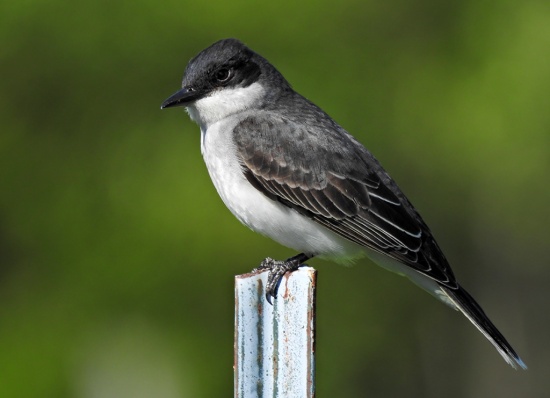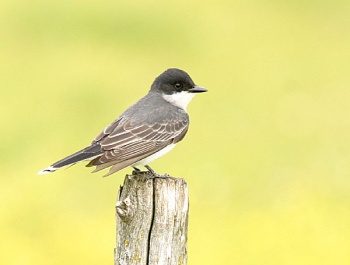Nomdeploom (talk | contribs) |
(→External Links: Multiple GSearches combined) |
||
| (19 intermediate revisions by 6 users not shown) | |||
| Line 1: | Line 1: | ||
| − | + | [[Image:DSCN33301.jpg|thumb|550px|right|Photo © by {{user|Aandeg|Aandeg}}<br />Western [[New York]], May 2015]] | |
| − | [[Image: | + | ;[[:Category:Tyrannus|Tyrannus]] tyrannus |
| − | |||
==Identification== | ==Identification== | ||
| − | Charcoal gray | + | [[Image:2288IMG 3961eaki.jpg|thumb|350px|right|Juvenile<br />Photo © by {{user|Kent|Kent}}<br />[[Minnesota]], [[USA]], June 2004]] |
| + | 19–23 cm (7½-9 in) | ||
| + | *Charcoal gray upperparts | ||
| + | *Black cap | ||
| + | *White throat and belly, some gray smudges on chest | ||
| + | *White tip on tail | ||
| + | *Sometimes shows orange, or yellowish-orange crown spot | ||
==Distribution== | ==Distribution== | ||
| + | This species breeds throughout much of the [[USA]] and [[Canada]]; absent only in [[Alaska]], [[Yukon Territory]], [[California]] most of [[Nevada]], southern [[Utah]], [[Arizona]], southern [[New Mexico]], and western [[Texas]]. | ||
| + | |||
| + | Winters in [[South America]]. | ||
| + | |||
| + | Rare vagrant in [[California]], [[Arizona]], [[Newfoundland]], and [[Alaska]]. | ||
==Taxonomy== | ==Taxonomy== | ||
| + | This is a [[Dictionary_M-O#M|monotypic]] species<sup>[[#References|[1]]]</sup>. | ||
| + | ==Habitat== | ||
| + | A variety of open areas with a few tall trees or powerlines and forests, including gallery forest, clearings and forest borders. | ||
| − | |||
==Behaviour== | ==Behaviour== | ||
| − | Often flies into the air from a perch to catch an insect (flycatching). | + | Often flies into the air from a perch to catch an insect (flycatching). |
| + | ====Diet==== | ||
| + | Their diet consists mostly of flying insects, particularly in the breeding season. They will also sometimes take small frogs. Fruit forms a large part of their diet too. | ||
| + | ==Gallery== | ||
| + | Click on photo for larger image | ||
| + | <gallery> | ||
| + | Image:DSC 52361.jpg|Showing yellow crown spot<br />{{user|boobird|boobird}}<br />Coldwater, [[Michigan]], May 2018 | ||
| + | Image:IMG 35232.JPG|Photo © by {{user|tetoneon|tetoneon}}<br />[[New Jersey]], [[USA]], May 2015 | ||
| + | </gallery> | ||
| + | ==References== | ||
| + | #{{Ref-Clements6thAug17}}#Handbook of the Birds of the World Alive (retrieved January 2016 & May 2018) | ||
| + | {{ref}} | ||
==External Links== | ==External Links== | ||
| − | {{GSearch|Tyrannus | + | {{GSearch|"Tyrannus tyrannus" {{!}} "Eastern Kingbird"}} |
| + | {{GS-checked}}1 | ||
| + | <br /> | ||
| + | <br /> | ||
| − | [[Category:Birds]][[ | + | [[Category:Birds]] [[Category:Tyrannus]] |
Latest revision as of 20:45, 23 March 2023
- Tyrannus tyrannus
Identification
19–23 cm (7½-9 in)
- Charcoal gray upperparts
- Black cap
- White throat and belly, some gray smudges on chest
- White tip on tail
- Sometimes shows orange, or yellowish-orange crown spot
Distribution
This species breeds throughout much of the USA and Canada; absent only in Alaska, Yukon Territory, California most of Nevada, southern Utah, Arizona, southern New Mexico, and western Texas.
Winters in South America.
Rare vagrant in California, Arizona, Newfoundland, and Alaska.
Taxonomy
This is a monotypic species[1].
Habitat
A variety of open areas with a few tall trees or powerlines and forests, including gallery forest, clearings and forest borders.
Behaviour
Often flies into the air from a perch to catch an insect (flycatching).
Diet
Their diet consists mostly of flying insects, particularly in the breeding season. They will also sometimes take small frogs. Fruit forms a large part of their diet too.
Gallery
Click on photo for larger image
Photo © by tetoneon
New Jersey, USA, May 2015
References
- Clements, J. F., T. S. Schulenberg, M. J. Iliff, D. Roberson, T. A. Fredericks, B. L. Sullivan, and C. L. Wood. 2017. The eBird/Clements checklist of birds of the world: v2017, with updates to August 2017. Downloaded from http://www.birds.cornell.edu/clementschecklist/download/
- Handbook of the Birds of the World Alive (retrieved January 2016 & May 2018)
Recommended Citation
- BirdForum Opus contributors. (2024) Eastern Kingbird. In: BirdForum, the forum for wild birds and birding. Retrieved 8 May 2024 from https://www.birdforum.net/opus/Eastern_Kingbird
External Links
GSearch checked for 2020 platform.1







